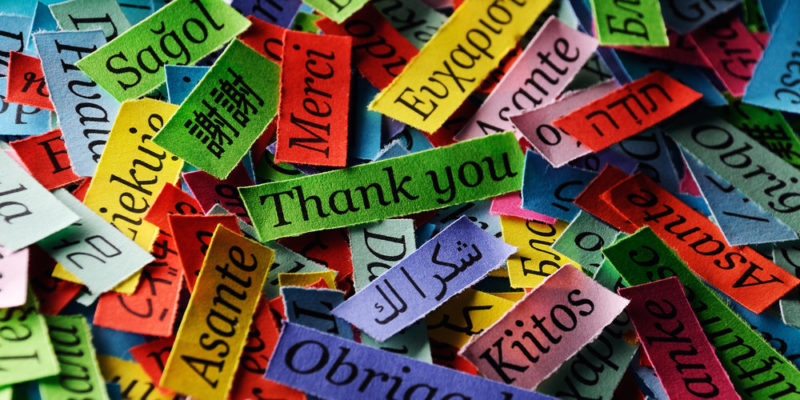We explain what languages ??are, how they are classified and what a dialect is. Also, what are its general characteristics and examples.
What are languages?
A language or a language is a verbal system of communication typical of the human species , which consists of a spoken chain of phonetic signs with which the message is encoded. Secondarily, languages can be represented through writing.
Languages are typical and characteristic of each organized human community , the product of its particular social and cultural history, its idiosyncrasies and its traditions. As it is spread over large and / or diverse geographical lengths, it is usually enunciated in a different way, giving rise to dialects .
In the world of language, many of the vital aspects of a community converge : its politics , its ancestral heritage, its way of representing the universe and at the same time its present needs, its social and even economic tendencies. In other words, language is a perfect reflection of the society to which it belongs.
Types of languages

There are different types of languages, depending on their social function, such as:
- Mother tongues: Those that an individual acquires as soon as he is born and learns to communicate. In other words, the first language we learn is our mother tongue.
- Living languages: Those that are spoken, remain active and update over time. They have native speakers and are therefore in constant use.
- Dead languages: On the other hand, dead languages no longer have speakers and are never updated, but remain as a historical fact, a linguistic museum piece. Nobody speaks them anymore.
- Official languages: Those chosen by a country or an organized human society as representative of its community , and which will therefore be used in official and bureaucratic communications .
- Liturgical languages: Those that are only used for specific types of events, acts or rituals, as occurs with Latin in some Catholic religious celebrations.
- Native languages: They are those that belong to a specific geographical or human region and have not undergone processes of fusion, transculturation or syncretism . It is the closest thing to a "pure" language, if that can exist.
Difference between language and dialect
There are no scientific or universal criteria to distinguish between a language and a dialect, this debate being more of a socio-political than a linguistic nature.
However, the concept of dialect refers to the different ways of elaborating or speaking the same language in the different geographic regions or communities that consider it as their own.
For example, it is possible to speak the American dialect and the peninsular dialect, when it comes to understanding the Spanish language; but within the American there are also 19 national dialects , one for each Hispanic-American country.
Language, speech and writing

These three concepts are often thought of as the same thing, but they are fundamentally different. Each is defined as:
- Language: The system of signs, meanings and sounds , which is shared, explained and serves as a set of rules for communication between its speakers. It is of an abstract type and is contained in memory .
- Speech: This is the name given to the very way in which each speaker or each group of speakers executes or puts into practice the same language. It is concrete, individual and exists in practice. For example, dialects are variations of speech, but they are part of the same language.
- Writing: It is a secondary system of representation of the sounds of the language, that is, a way of recording or translating them into visual marks, which can then be read to recover the same meaning of the said message.
Language families

There are many languages in the world, organized into a series of families, that is, groups that share their own origin and elements. Among them are:
- Indo-European languages: One of the largest language families in the world, made up of more than 150, which are spoken by 3.2 billion people in the world (45% of the total population). It is estimated that they all come from an Indo-European language that originated around 3000 BC. C. This family is divided into:
- Anatolio: Dead language.
- Greek-Armenian: Where the Greek and Armenian come from.
- Thracian-Dacian-Albanian women: Only the last survives.
- Italo-Celts: From where the Latin arose and, therefore, the Romance languages.
- Germanic: Where does the German, English and Nordic languages come from.
- Balto-Eslavas: Where do the Baltic languages like Lithuanian come from, and Slavic languages like Russian, Czech or Polish.
- Indoiranias: Where the languages of the Middle East and Central Asia come from , such as Persian, Hindi, Urdu, Pashtu, Nepali, Kurdish or Romani, among others.
- Tocarian: Dead and little known languages.
- Dravidian languages: A set of 26 languages from central and southern India and Ceylon (Sri Lanka). It is divided into southern, south central, central and northern. None of them are thought to be related to the rest of the languages.
- Japonic languages: These would descend from a proto-Japanese language, such as eastern and western Japanese, or the Ryukyuan languages (from the Ryukyu Islands in the south of the country).
- Sino-Tibetan languages: They are over 250 languages, spoken from North India (West), Taiwan (South East), China (North) to the Malay Peninsula (South). Its gigantic variety of languages is spoken in China, Thailand, Laos, Bhutan, Nepal , Bangladesh, Pakistan and India.
- Niger-Congo languages: The Niger-Congolese languages encompass 1,400 different languages and nearly 400 million speakers. They are classified into Niger-Congo A and Niger-Congo B, and it is one of the main African language families.
- Mayan languages: Also called Mayans, they come from ancient Mesoamerica and are spoken by almost 5 million speakers between Guatemala, Mexico , Belize and Honduras. It's divided in:
- Huastecan languages: Huasteco and Chicomucelteco, the latter already dead.
- Yucatecan language: The most widely spoken in Mexico.
- Western Mayan language: Like the Cholano, Tzeltalano and Kanjobalano.
- Eastern Mayan language: Like the quiché-mameano, the mameano, quichean and poqom.
How many languages are there in the world?
It is estimated that there are between 3 thousand and 7 thousand languages on the planet , but it is really impossible to determine the exact number, since many are difficult to differentiate from each other.
Some estimates warn of the disappearance of around half of the languages currently spoken, in favor of the majority languages, estimated for the year 2100.
Most spoken languages in the world

The main languages of the world in relation to their number of native speakers are:
- Chinese: Around 1,200 million speakers.
- Spanish: Around 400 million people.
- Hindi: 380 million speakers among the 23 existing variants.
- English: 360 million native speakers and 500 million second language speakers.
- Arabic: 250 million speakers worldwide.
Is it important?
Language is one of the most powerful tools created by humanity. In addition to its important communicative function, it enables the very fabric of societies.
Thanks to language, the construction of economies, religions, national and cultural identities is possible . Without languages, a civilization could not develop.
Language changes
Languages vary over time , according to an evolutionary process that attends to their forms of use (speech), in which the norm (language) is gradually modified.
This is called the mutability of the language : its ability to change, to be creative, to allow innovation in its speakers and not be a rigid order.
Language examples
Among the thousands of languages that exist, some examples are:
| English | Korean |
| Spanish | Pakistani |
| French | Mongolian |
| Portuguese | Albanian |
| Flemish | Czech |
| Catalan | Turkish |
| Galician | Iranian |
| Greek | Hebrew |
| Nahuatl | Hungarian |
| Quechua | Belarusian |
| Aymara | Creole |
| Swedish | Croatian |
| Polish | Irish |
| Russian | Welsh |
| Chinese | Khmer |
| Japanese | Vietnamese |
The above content published at Collaborative Research Group is for informational and educational purposes only and has been developed by referring reliable sources and recommendations from experts. We do not have any contact with official entities nor do we intend to replace the information that they emit.
Veronica is a culture reporter at Collaborative Research Group, where she writes about food, fitness, weird stuff on the internet, and, well, just about anything else. She has also covered technology news and has a penchant for smartphone stories. .
Leave a reply
Your email address will not be published. Required fields are marked *Recent post

Sport: What Is It, Types, Risks, Features, Characteristics and Examples

Dogs: Emergence, Features, Characteristics, Feeding and Breeds

Story: Definition, Elements, Structure, Features and Characteristics

